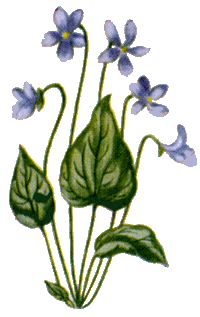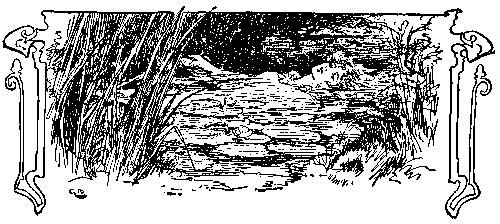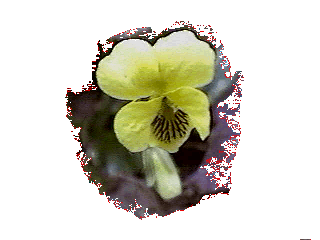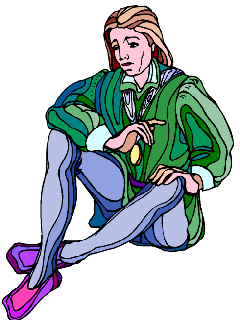| The Violet Gazette |
 |
Return to AVS Homepage
Return to The Violet Gazette Index
Return to The Spring 2001 Contents
Published by THE AMERICAN VIOLET SOCIETY
© 2001 All Rights Reserved.
Volume 2, Number 2
Spring 2001
On line Version
PAGE 5
Shakespeare's Violets
By Geraldine Adamich Laufer.
|
 |
|
|
|
|
|
AVS member Geraldine
Adamich Laufer is a noted horticulturist,
author, garden-circuit lecturer, and a columnist
for The Herb Companion. She is also the Public
Relations Manager for the Atlanta Botanical
Gardens.
Geri's
Books
|
|
|
|
Elizabethan
Herb
Song
|
Plant me a garden to heal the
body,
Betony, yarrow and daisies to mend,
Sage for the blood and comfrey for bones,
Foxglove and hyssop the sick to tend.
Refrain:
|
|
|
Tansy, rosemary, rue and thyme,
Bring back the lover who once was mine.
I will give him the sweet basil tree
Then he will always belong to me.
|
Plant me a garden to heal the
heart,
Balm for joy and the sweet violet,
Cowslips, pansies and chamomile,
To ease the pain I want to forget
Refrain:
Plant me a garden to heal
the soul,
A garden of peace and tranquility
Soothed with the scent of lavender
And the heavenly blue of chicory.
Refrain
|
|
|
|
|
|
|
|
|
|
The
Critics are agreed on one point; that is, that Shakespeare was
the most wonderfully many-sided writer the world has ever known.
In the scenes of his plays he paints a picture of the world as
he knew it, describing every occupation and hobby; every science
and art; every phase of the life of his time.
Flowers, plants and herbs are not neglected. William Shakespeare
grew up a country boy and never lost his love for flowers. In
his writings, his strong feelings for flowers and gardening, and
his wide (though perhaps not deep) knowledge of plants shines
through. More than 200 plants, wild and cultivated, are
mentioned in his plays and sonnets. In a few simple words and
with a few natural touches he brings before his readers the
familiar plants he knew in the hedgerows of the Warwickshire
countryside.
Flowers and herbs come before the reader in the most natural
way, as if the flower named was the only one that could possibly
be cited on that occasion. His descriptions are thoroughly fresh
and real, and tell of the pleasure he had in the familiar plants
of the English countryside and the local cottage gardens.
The Elizabethans valued flowers and herbs in a way quite
different than today. They depended on plants not only for food
and shelter, but for many other purposes. Herbs were required
for flavoring, stuffing, garnishing and for seasoning wines.
Their clothes were dyed with vegetable dyes. There was no
medicine as we know it, and people depended on
"simples" concocted of plants with real or imagined
virtues. Modern science did not exist, and consequently medicine
and magic often overlapped. Additionally, Elizabethan audiences
were much more familiar with plant symbolism than are today's
audiences, so many of Shakespeare's finest points are made with
allusions to floral sentiments and meanings. Cosmetic uses for
herbs were numerous, and ranged from sweet-scented oils to
fanciful "cures" for baldness. Flowers were used
ornamentally in pleasure gardens, first seen in Elizabethan
times, both for their fragrance and for their subtle colors. In
cooking, strong flavors were needed to mask rancid odors in the
days before refrigeration, and herbs and edible flowers were
used to vary the sameness of the winter diet. Soothing and
refreshing herbal teas were popular in Shakespeare's time-before
China tea or South American coffee were widely known-because
they were available and could be grown at home, and because
water was thought to be unfit to drink! This dependence on
plants extended to every aspect of life in Shakespeare's world.
Shakespeare loved the sweet and humble violet, one of the first
flowers to bloom and a harbinger of spring. Dozens of quotes
name the demure violet that greets the early spring with
fragrant perfume and blue blossoms. One of the important writers
on "plants of Shakespeare," F. G. Savage, in The Flora
and Folklore of Shakespeare (1923) writes, "Nothing
respecting the flower escaped the eye of the poet, its colour,
scent, habit of growth, and tender purposes for which it was
employed, are all beautifully set forth in the eighteen passages
in which it is mentioned with an exactness unsurpassable and
quite impossible to anyone not thoroughly conversant with the
hidden charm and beauties of this, most modest of coy
flowers.".
|
 |
|
Hamlet (Act I, scene 3.)
|
"A violet in the youth of primy
nature,
Forward, not permanent."
|
|
|
|
Sonnet XCIX
|
"The forward violet thus I did
chide-
Sweet thief, whence didst thou steal thy sweet that smells
If not from my love's breath?"
|
|
|
|
Love's Labours Lost (Act V,
scene 2.)
|
|
"Daisies pied and violets blue And
lady-smocks all silver-white."
|
|
|
|
A
favorite quotation from A Midsummer Night's Dream names the
violet along with several other fragrant flowers:
|
|
A Midsummer Night's Dream (Act
II, scene 1.)
|
"I know a bank whereon the wild thyme blows,
Where oxlips and the nodding violet grows,
Quite over-canopied with luscious woodbine,
With sweet musk-roses and with eglantine.
There sleeps Titania, some time of the night,
Lull'd in these flowers with dances and delight.".
|
|

|
|
|
Or
another bank of violets:
|

|
|
Twelfth Night (Act I,
scene 1.)
|
"Like the sweet sound,
That breathes upon a bank of violets."
|
|
|
|
King Richard II (Act V,
scene 2.)
|
"Welcome my son: who are
the violets now
That strew the green lap of the new come
spring?"
|
|
Illusions
to death and to the grave sometime include the violet:
|
|
Pericles (Act IV, scene 1.)
|
"Purple violets and marigolds,
Shall as a carpet hang upon thy grave."
|
|

|
|
After
Ophelia's demise, the wish is expressed that: |
|

|
|
Hamlet (Act V, scene 1.)
|
"From her fair and unpolluted flesh May violets spring!"
|
|
Ophelia's
wilted violets allude to the fact that something was not quite right
("rotten in the state of Denmark") about the death of her
father.
|
|

|
|
Hamlet (Act IV, scene 5.)
|
"There's a daisy: I would give you some violets but they
withered all when my Father died."
|
|
Many
of Shakespeare's lines and phrases have left the realm of literature and
jumped into the common language. For example, 'to gild the lily'
referring to a surfeit or overabundance derives from a quotation that
originally included the heavenly fragrance of the violet:
|

|
|
King John (Act IV, scene 2.)
|
"To gild refined gold, to paint the lily,
To throw a perfume on the violet, . . .
Is wasteful and ridiculous excess."
|
|
And
the humble violet is named when referring to the humanity of the King:
|
|
King Henry V (Act IV, scene 1.)
|
"I think the king is but a man, as I am;
The violet smells the same to him as it doth to me."
|
|

|
|
The
Bard delighted in violets, and among those native to his English isles
were Viola odorata, V. reichenbachiana (formerly V. sylvatica), V. hirta
and V. canina. Embodied in Shakespeare's thoughtful lines are truths
known from our own gardens, and it is fascinating to speculate that the
violets we love today are the same plants that William Shakespeare
immortalized in his plays. |
|
|
|
© 2001 Geraldine Adamich Laufer
For The American Violet Society
All Rights Reserved
|
|
|
|
Return to The Spring 2001 Contents
Return to The Violet Gazette Index
Return to AVS Homepage
|
|